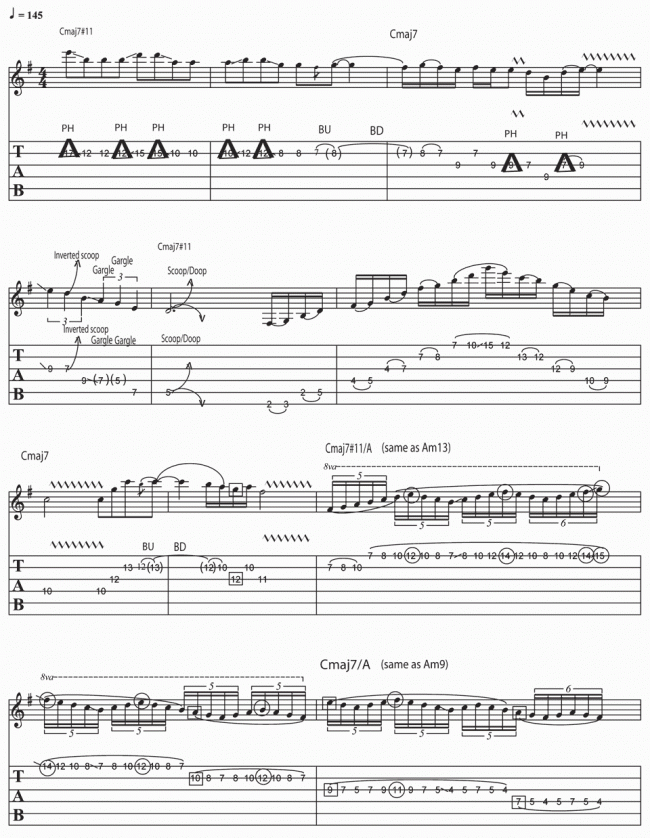
This last example is a solo study based on some of Steve Vai’s trademark techniques and improvisational devices. The backing track is based on C Lydian (R 2 3 #4 5 6 7 ) for the first four bars, followed by a change to A Dorian (R 2 b3 4 5 6 b7) for the next five bars. Both these modes are in the key of Gmajor, and in fact the same vocabulary of ideas can be used over both of these modal sounds. The first half of the solo is played using a wah pedal, the first four bars with the wah fully forward in it’s treble position. This sharp and cutting tone especially helps to bring out the pinch harmonics that are featured in the first three bars. In bars 4-5, there is some whammy bar work, that serves to highlight the way Vai applies different sounds to each individual note of a melody line. I would advise memorising the line without any nuance, and then working on each note separately with the whammy bar, firstly a reverse slide into the first note of the phrase, then an upwards scoop on the second note, followed by a plain note then two gargles before finishing with a scoop/doop! Then in bars 5 and 6 there is an ascending three octave Gmaj7 arp which slides up to the fifteenth fret and descends a Cmaj7 arpeggio, both these arpeggios are in the key of G and are commonly superimposed over both C Lydian and A Dorian progressions.
Bars 7 and 8 contain a semi tone bend, so good intonation is required and this leads to a phrase that utilises a left hand hammer. It is very common in modern rock solos to see this feature as it saves extra pick work and allows a smoother tone.
Bars 9-12 feature a long fluid legato run that is extended on the top three strings with some right hand tapped notes. The run is in the key of G, the underlying tonal centre has now changed to A Dorian. From a vocabulary point of view, this run will in fact work well over any mode in the key of G major. Once the first note has been picked, there is no more picking at all until the phrase concludes with a pinch harmonic. Again, left handed tapping is used to cross the strings, with slides enabling the shift from one position to the next. Although the groupings are comprised of fives, sixes and sevens, you would benefit from learning this initially as semi quavers to a metronome, with all notes evenly spaced, picking up on the overall feel of the run by listening to the example. Often the reason for the varied groupings is a result of intentional acceleration and deceleration as you feel the target note approaching.
Bars 13 and 14 features a cool intervallic idea with whammy scoops. Be careful muting any unwanted string noise as with lots of gain, the whammy can cause serious disturbance! Remember to mute the string above the one you are playing with your left hand index finger tip.Try to hold the whammy bar in between your right hand third and fourth fingers, enabling you to pick the first note of each string.
Bar 15 features a very rapid position shift that will need to be practiced slowly to get the accuracy. Again, you’ll notice a left handed tap before the pinch harmonics at the end of the bar. Lastly in bar 16, there is a Vai trademark pentatonic run. This run can be confusing at first as it contains double notes, in other words the same note is played on two separate strings. Concentrate on the timing and be aware of the left handed taps. The run will require a full stretch in this key, so place the thumb around the lower part of the neck and open your hand span right out so that the fingers are hovering over the frets. The solo ends in bar 17 with a pinch harmonic tone-wide vibrato note. All of these components should be broken down step by step and worked on in isolation until proficiency is gained. Then start linking some of the elements together and from there start to build the profile of the entire piece.
Audio clip: Adobe Flash Player (version 9 or above) is required to play this audio clip. Download the latest version here. You also need to have JavaScript enabled in your browser.



